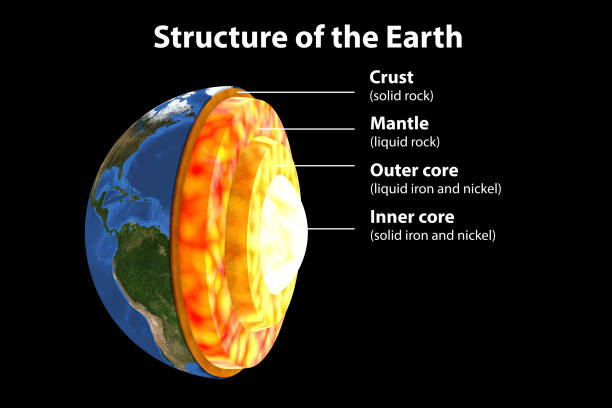Earth’s Core Is Leaking, Says Scientists
Scientists have identified an unexpected quantity of a rare type of helium, known as helium-3, in volcanic rocks found on Canada’s Baffin Island. This discovery supports the theory that this noble gas is emanating from the Earth’s core and has been doing so for millennia. The research team also detected helium-4 in these rocks.
Despite helium-4’s common presence on Earth, it is surprising that these Baffin Island rocks revealed a greater quantity of helium-3 than previously reported, a groundbreaking discovery recently published in the journal Nature.
Forrest Horton, the study’s lead author and an associate scientist in the department of geology and geophysics at Woods Hole Oceanographic Institution, explained that helium-3’s scarcity in the universe compared to helium-4 is evident at its most fundamental level.
ALSO READ: Why Many Kenyan Women Still Die While Giving Birth
Horton explains, ‘Helium-3 is rare on Earth because it hasn’t been generated or added to the planet in significant quantities, and it is lost to space as Earth’s solid layer undergoes convection. As material rises, cools, and descends, it loses helium to the atmosphere and eventually to space.'”
The detection of elements leaking from the Earth’s core provides valuable insights into the planet’s formation and evolution, and these new findings offer evidence to support an existing hypothesis regarding Earth’s origins.
During her doctoral studies at the University of Edinburgh under the direction of scientist Finlay Stuart, Solveigh Lass-Evans made the initial discovery of the high helium-3 to helium-4 ratio in volcanic rocks on Baffin Island. These findings were initially published in Nature in 2003.
The elements that made up a planet can be seen in its composition. Previous research suggested that small amounts of helium-3 escaping from Earth’s core fit with the generally accepted idea that our planet formed in a solar nebula, which was a cloud of gas and dust likely caused by a nearby supernova explosion and contained this element.
Horton and his team took the investigation a step further in 2018 when they examined the lava that erupted millions of years ago when Greenland and North America separated, creating a new seafloor. Their aim was to explore the rocks that might hold clues about the materials hidden within the Earth’s core and mantle, the solid layer beneath the Earth’s surface.
ALSO READ: Weed and Brain: Impact of Marijuana Use on Higher-Level Thinking
To access this remote and otherworldly landscape on Baffin Island, the researchers used helicopters. Polar bears guarded the coastline, enormous icebergs floated by, and lava flows had created tall cliffs here. Local organizations, including the Qikiqtani Inuit Association and Nunavut Research Institute, facilitated the research and offered protection against bears, according to Horton.
The Arctic rocks studied by Horton’s team exhibited surprisingly higher levels of helium-3 and helium-4 than previous research had reported, and these measurements varied among the samples they collected.

Horton enthusiastically described the experience of breaking off fresh pieces of the lavas, which are abundant in bright green olivine, also known as the gemstone peridot, with a rock hammer as akin to the excitement of breaking geodes as a child; each rock held the promise of a hidden treasure.
Horton pointed out that only one helium-3 atom exists for every million helium-4 atoms, and the team measured around 10 million helium-3 atoms per gram of olivine crystals.
“Our high 3He/4He measurements suggest that gases, likely inherited from the solar nebula during the formation of the solar system, are more effectively retained in Earth than previously believed,” he said.
ALSO READ: Tuberculosis Myths And Facts
The origin of this phenomenon may date back to the Big Bang, which not only created the universe but also released abundant hydrogen and helium. Over time, these elements have been incorporated into the formation of galaxies.
Scientists theorize that our solar system formed 4.5 billion years ago within a solar nebula. As the dust cloud collapsed during a supernova, the resulting material formed a spinning disk that eventually gave rise to our sun and the planets, as per NASA.
Helium inherited from the solar nebula likely became trapped in the Earth’s core as the planet was forming, transforming the core into a reservoir of noble gases. As helium-3 leaked from the core, it ascended to the surface through the mantle in the form of magma plumes, which eventually erupted on Baffin Island.
Horton explained, “During the eruption, the vast majority of the gases in the magma escaped into the atmosphere. Only the olivine crystals that formed before the eruption preserved the helium from the deep Earth.”
While helium leaking from the Earth’s core does not impact the planet or have adverse effects, Horton mentioned that this noble gas does not chemically react with matter, thus posing no threat to humanity or the environment.
ALSO READ: Sleeping 5 Hours or Less a Night Risks Health Problems as You Age
In their next steps, the research team intends to explore whether the Earth’s core may store other lightweight elements, potentially explaining why the Earth’s outer core is less dense than anticipated.
Horton stated, “Is the core a significant repository of elements such as carbon and hydrogen, which are crucial for planetary habitability? If so, have flows of these elements from the core throughout Earth’s history influenced planetary evolution? I’m excited to investigate connections between helium and other lightweight elements across the core-mantle boundary.”
Earth’s Core Is Leaking, Says Scientists


